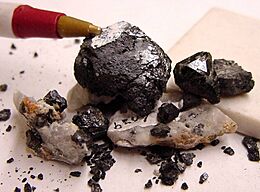Hercynite facts for kids
Quick facts for kids Hercynite |
|
|---|---|
 |
|
| General | |
| Category | Oxide minerals Spinel group Spinel structural group |
| Formula (repeating unit) |
Fe2+Al2O4 |
| Strunz classification | 4.BB.05 |
| Crystal symmetry | Fd3m (no. 227) |
| Identification | |
| Formula mass | 173.81 g/mol |
| Color | Black |
| Crystal habit | Euhedral crystals. Also massive to granular |
| Crystal system | Isometric |
| Cleavage | [111] indistinct |
| Fracture | Uneven – flat surfaces (not cleavage) fractured in an uneven pattern. |
| Mohs scale hardness | 7.5 |
| Luster | Vitreous (glassy) |
| Streak | dark green |
| Specific gravity | 3.95 |
| Optical properties | Isotropic |
| Refractive index | n = 1.8 |
| Other characteristics | non-radioactive |
Hercynite is a fascinating mineral that belongs to the Spinel group. Think of it as a special type of spinel that contains both iron and aluminum. Its chemical formula is FeAl2O4, which tells us it's made of iron (Fe), aluminum (Al), and oxygen (O).
Contents
What is Hercynite?
Hercynite is an oxide mineral, meaning it's formed when a metal (in this case, iron and aluminum) combines with oxygen. It's part of the larger spinel family, which includes many important minerals. Hercynite usually appears as a black mineral with a shiny, glassy look.
Hercynite's Chemical Makeup
At its core, Hercynite is built from iron ions (Fe2+) and aluminum ions (Al3+) arranged in a specific way within its crystal structure. Sometimes, you might even find a little bit of a different type of iron ion (Fe3+) mixed in. This arrangement of atoms gives Hercynite its unique properties.
Where Can You Find Hercynite?
Hercynite isn't found just anywhere! It forms under very specific conditions, often deep within the Earth.
Rocks Changed by Heat and Pressure
One common place to find Hercynite is in rocks that have been intensely changed by heat and pressure. Imagine clay-rich sediments that get buried deep underground. The immense heat and pressure transform them into new, harder rocks. If these original sediments had a lot of iron, Hercynite can form there. Geologists call this process metamorphism, and the rocks are called metamorphic rocks.
Rocks from Cooled Magma
You can also discover Hercynite in certain types of igneous rocks. These are rocks that form when molten rock (magma or lava) cools down and solidifies. Hercynite is typically found in mafic and ultramafic igneous rocks. These are usually dark-colored rocks that are rich in minerals containing iron and magnesium.
Found in Riverbeds and Beaches
Because Hercynite is quite hard (it scores 7.5 on the Mohs scale of mineral hardness, which is pretty tough!), it can survive being weathered out of its original rocks. This means it can be carried by rivers and streams and eventually settle in places where heavy minerals collect, like riverbeds or beaches. These collections are known as placer deposits.
The Story Behind the Name
Hercynite was first officially described by scientists in 1847. Its name comes from a historical place! It's named after the Harz mountains in Germany, which were once known by their Latin name, Silva Hercynia. This is where the mineral was first discovered.
Hercynite's Cool Properties
Hercynite has several interesting characteristics that help scientists identify it:
- Color: It's typically black.
- Luster: It has a vitreous luster, meaning it looks like glass when light reflects off it.
- Hardness: As mentioned, it's quite hard, scoring 7.5 on the Mohs scale. This means it can scratch glass and many other minerals.
- Streak: If you rub Hercynite against an unglazed porcelain plate, it leaves a dark green streak.
- Density: It's relatively dense, with a specific gravity of about 3.95. This means it's nearly four times heavier than an equal volume of water.
- Melting Point: This mineral can withstand a lot of heat! It melts at very high temperatures, somewhere between 1692 and 1767 degrees Celsius (that's 3078 to 3213 degrees Fahrenheit!).
Hercynite is a non-radioactive mineral, meaning it doesn't give off radiation.

